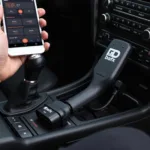Understanding your car’s health just got easier with an OBD2 EOBD code reader. This handy device acts as your personal auto drive mechanic, letting you diagnose issues and potentially save money on costly repairs. Whether you’re a car enthusiast or simply want to be more informed about your vehicle, an OBD2 EOBD code reader is an invaluable tool.
What is an OBD2 EOBD Code Reader?
OBD stands for On-Board Diagnostics, and EOBD is its European counterpart (European On-Board Diagnostics). Essentially, these systems monitor your vehicle’s engine and emission control systems. When a problem arises, the system stores a specific code in the car’s computer. An OBD2 EOBD code reader allows you to access and interpret these codes, revealing the source of the issue.
How Does an OBD2 EOBD Code Reader Work?
Using an OBD2 EOBD code reader is incredibly simple. Most readers connect to your vehicle’s OBD2 port, usually located under the dashboard on the driver’s side. Once connected, the reader communicates with your car’s computer and retrieves the stored trouble codes.
Many modern code readers display the code definitions directly on their screen, eliminating the need to look up codes in a manual. Some advanced readers even offer additional features like live data streaming, which allows you to monitor various engine parameters in real-time.
Benefits of Owning an OBD2 EOBD Code Reader
Owning an OBD2 EOBD code reader offers numerous benefits:
- Early Problem Detection: Identifying issues early can prevent costly repairs down the road.
- Cost Savings: Diagnosing problems yourself can save you money on mechanic fees.
- Increased Knowledge: Understand your car better and become a more informed car owner.
- Peace of Mind: Gain confidence in knowing what’s happening with your vehicle.
- DIY Repairs: For the mechanically inclined, a code reader can assist in DIY repairs.
Choosing the Right OBD2 EOBD Code Reader for You
With a wide variety of OBD2 EOBD code readers on the market, selecting the right one can seem daunting. Here are key factors to consider:
- Vehicle Compatibility: Ensure the reader is compatible with your car’s make, model, and year.
- Features: Basic readers display codes, while advanced models offer live data, graphing, and more.
- Ease of Use: Choose a reader with a user-friendly interface and clear instructions.
- Budget: Prices vary widely; determine your needs and set a budget accordingly.
- Reviews: Research and read reviews from other users to gauge reliability and performance.
 Various OBD2 Code Readers
Various OBD2 Code Readers
Common OBD2 EOBD Codes and Their Meanings
While a code reader will often provide a code definition, here are some common OBD2 EOBD codes and their meanings:
- P0420: Catalyst System Efficiency Below Threshold (Bank 1) – Indicates a problem with the catalytic converter.
- P0300: Random/Multiple Cylinder Misfire Detected – A common code that can point to various ignition system issues.
- P0171: System Too Lean (Bank 1) – Indicates an issue with the air/fuel mixture, often a vacuum leak.
- P0135: O2 Sensor Heater Circuit Malfunction (Bank 1, Sensor 1) – A problem with the oxygen sensor heater circuit.
- P0442: Evaporative Emission Control System Leak Detected (Small Leak) – Points to a leak in the EVAP system, often the gas cap.
Empowering Car Owners with Knowledge
OBD2 EOBD code readers have revolutionized car maintenance by empowering car owners with knowledge. With the ability to understand their car’s health, drivers can now make informed decisions about repairs and maintenance.
Whether you’re a seasoned mechanic or a curious car owner, an OBD2 EOBD code reader is an essential tool for anyone looking to take control of their car’s well-being.

